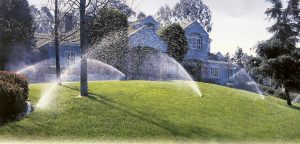Summer Watering Guidelines for Texas Lawns

Many homeowners get nervous when summer rolls around in central Texas because they know the extreme humidity and dry heat can be fatal to their lawns. Keeping your grass properly nourished and watered is essential to helping it stay green well into autumn. Your city or neighborhood may have predetermined watering schedules in place for summer, so be mindful of those as well as you take care of your lawn. The following Texas lawn care tips can help you keep your grass in good shape all summer long.
How Often Should I Water My Lawn?
Watering infrequently and deeply is the key to a healthy Texas lawn. This technique helps plants grow longer, tougher roots that will allow them to access water throughout the summer even as temperatures rise. Another tip: water your lawn earlier in the morning or later in the evening, when the sun is weakest. This will prevent the water from instantly evaporating and going to waste.
How Much Water Does Grass Need?
Typically, the average Texas lawn only needs about an inch of water per week, even in the hottest summers. If you’re unsure how long it takes to reach an inch of water, you can put a cup or can in your yard with an inch high marker and then time how long it takes to fill. In general, automatic irrigation systems disperse water at a much quicker rate than hose-end sprinklers. Start with shorter times and add additional time if large areas of damaged or dried-out grass appear. Of course, if there has been significant rainfall recently, you do not need to re-water.
Watering Guidelines for Different Types of Grass
Your yard’s grass type can also affect how much water is necessary for your lawn. Each grass variety has different tolerances for heat and water, so these guidelines are good to keep in mind.
St. Augustine: This is a common choice for yards, but is rather vulnerable to lawn diseases and pests that Texas summers can bring. It requires a lot of water to stay healthy, which can present a problem if you are in an area with restricted water access.
Bermuda: Bermuda grass is great in the sun and is very resistant to drought. It can grow and thrive even with very little watering. If you live in an especially dry region of Texas, Bermuda grass is a solid choice.
Buffalo: This type of grass is very tolerant of droughts, but it will start to brown later in the summer if it isn’t adequately watered. However, since Buffalo grass is native to Texas, it is rather resilient and can survive through the dry summers.
Zoysia: Another drought-resistant grass, Zoysia can also survive without excessive watering. It will often stay lush even in the shade, staying true to its soft and luxurious texture.
Caring for your Texas lawn in the summer can be tricky, but it need not feel impossible. By sticking to a regular watering schedule that fits your lawn’s needs, you can keep your grass healthy, lush, and green all through the hot season.





